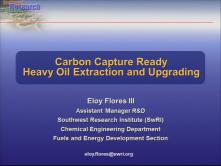Webinars & Conference Presentations
Improved solvent reaction kinetics and carbon capacity continue to be a major research interest for the scrubbing of CO2 in post-combustion processes. The DOE has set a new target for post-combustion CO2 capture of less than a 35% increase in the cost of electricity, while capturing at least 90...Read more
Introduction
Fossil fuels supply a majority of the world's energy needs. However, the combustion of fossil fuels is one of the major sources of the greenhouse gas CO2. Integrated gasification combined cycle (IGCC) is one the most efficient
Today’s chemical industry is very complex with most commodity chemicals being produced from some variation of petroleum feedstocks. From transportation fuels to polymers, petroleum is truly the largest source of basic hydrocarbons for which many of the common household products...Read more
The Integrated Gasification Combined Cycle (IGCC) is a promising technology for the future use of coal to provide energy. During this process, many of the trace elements present in coal are volatilized, and remain in the gas phase through the gas turbine, only to be released in the flue gas....Read more
Gas Technology Institute (GTI) and PoroGen Corporation are jointly developing a novel hybrid membrane – absorption process for pre- and post-combustion CO2 capture (Carbo-Lock™ process). The novel Carbo-Lock™ process combines advantageous features of both absorption and membrane processes to...Read more
Global climate models indicate that acting rapidly to reduce carbon dioxide emissions will provide greater benefits to the environment than delaying action; however, new technologies, currently under development, may be significantly less costly than those currently ready to be deployed. This...Read more
In the carbon capture and sequestration (CCS )scenario, vapor liquid equilibrium (VLE) curves represent the theoretical relationship between local gaseous CO2 vapor pressure and the respective carbon loading in solution for a given operating temperature. It determines the maximum carbon content...Read more
CO2 + 3H2 ➝ CH3OH + H2O
...Read moreGasification of coal – a low-cost and abundant domestic feedstock – and subsequent conversion to hydrogen and energy with simultaneous CO2 capture can improve national energy security in an environmentally responsible manner. To fulfill the promise of clean energy production through gasification...Read more
Complimentary Theoretical and Experimental Studies: CO2 Capture with Supported Ionic Liquid Membrane
This paper reports on recent results relating to high temperature sorption of metallic mercury on MinPlus sorbent, an inorganic substrate derived from paper recycling residues. Results from a packed bed reactor as well as in-flow dispersed phase reactor are reported. A new type of packed bed was...Read more
Despite the lack of a global greenhouse gas emission reduction agreement, regional schemes are moving forward to limit CO2 and other GHG emissions to the atmosphere. In the United States, the state of California is moving forward with regulations that will cap...Read more
Carbon dioxide emissions from heavy oil production are typically higher than that of producing conventional crudes. Ultimately, carbon dioxide emissions can make heavy oil production less competitive if regulated. Carbon dioxide emission regulations will affect the overall...Read more
This webinar is of benefit to engineers involved in the design of chemical processes, and faculty at universities who teach courses and carry out research in process flowsheet design.Read more
In this webinar, we will summarize the outcomes of the workshop, and elaborate on the path determined for 2010.Read more


















